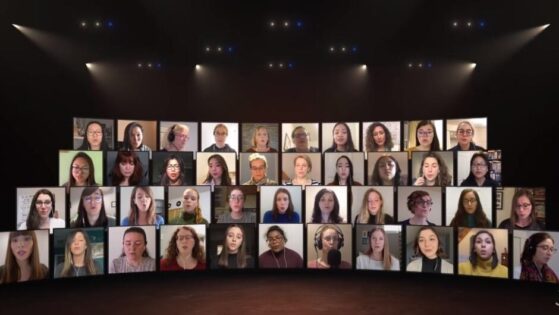Tips on Virtual Choir Coordination | Creating Harmony Online
The world of music, like many other fields, has undergone a significant transformation with the rise of digital technology. Choirs, which once thrived in physical spaces filled with the warmth of in-person harmonies, have had to adapt to the digital realm. Coordinating a virtual choir comes with unique challenges, from technical constraints to maintaining group synergy without a shared physical space. However, with thoughtful preparation and specific strategies, virtual choirs can be as impactful and moving as live performances. To help you navigate this process, here are comprehensive tips for successfully coordinating a virtual choir.

Select the Right Technology Platform
First and foremost, the choice of technology can make or break your virtual choir project. It’s essential to use platforms that allow for high-quality audio and video recordings. Here are a few reliable options:
- Zoom: Ideal for live rehearsals with its video and audio sharing capabilities.
- Acapella by Mixcord: A mobile app that lets you record, edit, and share music collaborations.
- Soundtrap: Perfect for creating, mixing, and collaborating on recordings with real-time audio editing features.
- GarageBand or Audacity: Effective tools for audio mixing if you’re handling post-production editing yourself.
Before settling on a platform, assess the specific needs of your choir, such as ease of use, number of participants, and compatibility with devices. Additionally, test your chosen platform in advance to ensure a seamless experience during rehearsals and recordings. These tips on virtual choir coordination will help guide you in choosing and preparing the best technology to support your ensemble.

Prepare Clear Guidelines for Participants
Next, it’s important to set your participants up for success by providing comprehensive instructions. For many choir members, virtual coordination may be a new experience, so clarity is key. Providing detailed guidelines ensures consistency and quality in each submission. Key points to include in your guidelines are:
- Technical Requirements: Specify the type of device, microphone, and recording software preferred.
- Audio and Video Settings: Explain how to position cameras for a well-lit shot, reduce background noise, and set audio input levels.
- File Format and Naming Conventions: Uniformity in file names (e.g., “Name_Part_Song_Title”) helps streamline the editing process.
- Deadline for Submissions: Clear timelines ensure that your project stays on track.
Moreover, consider sending visual examples or video tutorials to make the instructions easier to follow.

Focus on Synchronization
Synchronization is crucial for maintaining a cohesive performance. Since latency issues make real-time singing difficult, singers often need to record their parts individually and sync them later. To keep synchronization in check, here are some tips:
- Guide Tracks: Create a master guide track with a metronome click or instrumental accompaniment. This track should include clear cues for entries and cut-offs so that all singers stay in time.
- Count-Ins and Visual Cues: Encourage singers to clap or snap on the first beat as a visual cue. This clap helps align video and audio during the editing process.
- Uniform Tempo: Make sure the guide track is recorded at a consistent tempo, and encourage participants to practice with it before recording their final submissions.
Furthermore, double-check that all participants have easy access to the guide track to avoid any discrepancies.

Maintain a Strong Sense of Community
One of the biggest challenges of virtual choirs is fostering a sense of togetherness. Without physical rehearsals, it’s easy for participants to feel disconnected. To mitigate this, try the following:
- Regular Check-Ins: Schedule video meetings where choir members can interact, share progress, and provide feedback.
- Social Media Groups: Create a group chat or forum where members can exchange tips, ask questions, or simply chat.
- Virtual Team-Building Activities: Use games or shared listening sessions to maintain morale and camaraderie.
Additionally, remember that regular check-ins can make participants feel valued and engaged, strengthening the choir’s bond. Incorporating these Tips on Virtual Choir coordination into your practice helps maintain enthusiasm and a sense of community, ensuring members stay committed and connected throughout the project.

Incorporate Vocal Warm-Ups and Exercises
Effective rehearsals still matter in the virtual world. Therefore, start each online session with a series of vocal warm-ups that are tailored to the choir’s needs. These might include:
- Breathing Exercises: Practice deep diaphragmatic breathing to enhance vocal support.
- Scale Runs and Arpeggios: Warm up with scales that stretch across the full vocal range.
- Articulation Drills: Use tongue twisters and staccato exercises to improve clarity and precision.
Ensure that your warm-up routines are short but effective, taking no more than 10–15 minutes per rehearsal session. This not only prepares the voice but also brings everyone into a focused and unified mindset.

Communicate Clearly and Consistently
To keep everyone aligned and motivated, consistent communication is essential. Here’s how to manage it effectively:
- Weekly Updates: Send out emails or messages with updates, tips, and reminders about upcoming deadlines.
- Feedback Channels: Provide a system for members to receive constructive feedback on their recordings. This could be through private messages or group sessions where everyone listens and learns from others’ performances.
- Progress Videos: Share occasional clips of compiled rehearsals or work-in-progress edits to show how the final product is coming together.
Additionally, using communication tools like Slack or WhatsApp can facilitate easy back-and-forth conversations between the choir director and members.

Guide the Recording Process
Recording independently can be daunting for many choir members. To make the process easier, keep these pointers in mind:
- Background and Ambiance: Recommend a quiet space with minimal visual distractions and proper lighting. A plain background works best for uniformity.
- Headphones: Insist that singers use headphones while recording to avoid the guide track’s audio bleeding into their recording.
- Positioning: Advise singers to maintain a consistent distance from their microphones to avoid varying volume levels. The camera should capture them from the shoulders up for optimal framing.
Moreover, remind participants to do a short test recording and review it for sound quality and camera angle before submitting their final version.

Professional Editing and Mixing
Once all the recordings are submitted, the post-production phase begins. This stage is arguably the most technical part of virtual choir coordination. For this phase, having basic audio and video editing skills or working with a professional editor is beneficial. Here’s what to focus on:
- Audio Balancing: Mix each voice to create a balanced blend. Apply EQ and compression to enhance sound quality, and remove any background noise if necessary.
- Video Synchronization: Use software like Adobe Premiere Pro, Final Cut Pro, or even simpler tools like iMovie to align the videos.
- Special Effects: Consider adding creative elements such as virtual backgrounds, color themes, or text overlays to make the final video visually engaging.
In addition, keep a backup of all raw recordings until the final product is complete, just in case any editing adjustments are needed.

Plan for Challenges
Even with the best preparation, challenges are inevitable. To stay ahead, it’s crucial to anticipate and plan for common obstacles, including:
- Late Submissions: Have a buffer period for late submissions, but make it clear that sticking to deadlines is essential for the project’s success.
- Technical Glitches: Some members may face connectivity or software issues. Offer technical support or create a step-by-step troubleshooting guide.
- Re-recording Requests: Occasionally, certain parts may need to be re-recorded for quality. Maintain a positive tone when asking for re-dos and emphasize how important the contribution is to the overall performance.
Furthermore, maintaining open lines of communication can help resolve these challenges swiftly and without stress.

Show Appreciation and Celebrate Achievements
Finally, once the final video is compiled, celebrate the hard work that everyone put into the project:
- Virtual Premiere Night: Host an online viewing party where everyone can watch the final performance together.
- Share Widely: Post the video on social media platforms, your choir’s website, or video-sharing sites like YouTube. Tag participants and thank them publicly to show your appreciation.
- Feedback Roundtable: Invite choir members to share their thoughts on the project. Gather feedback for future improvements and to enhance the experience.
Additionally, recognizing individual contributions and applauding the group’s effort fosters a positive and motivated atmosphere.

Conclusion
Coordinating a virtual choir is a complex endeavor that requires more than just singing into a camera. However, with careful planning, clear communication, and the right technology, you can successfully bring the spirit of choral music to life online. By following these tips on virtual choir coordination, you can create a collaborative and enjoyable experience for your choir members, ultimately delivering performances that resonate with audiences.
Furthermore, virtual choirs are a testament to the resilience of music, showing that even in times of physical distance, voices can still unite to create beauty. Therefore, embrace the process, learn from each project, and continue to innovate. Over time, your choir’s journey may inspire others to join the symphony of digital harmony.
Additionally, if you’re ready to take your choir’s performance to the next level, consider joining our Choir Competition. This is a great opportunity to showcase your choir’s talent and connect with other music enthusiasts.









One thought on “Tips on Virtual Choir Coordination | Creating Harmony Online”
CommentAccording to the paragraph, how can virtual choirs achieve the same emotional impact as live performances? Greeting : Open CourseWare